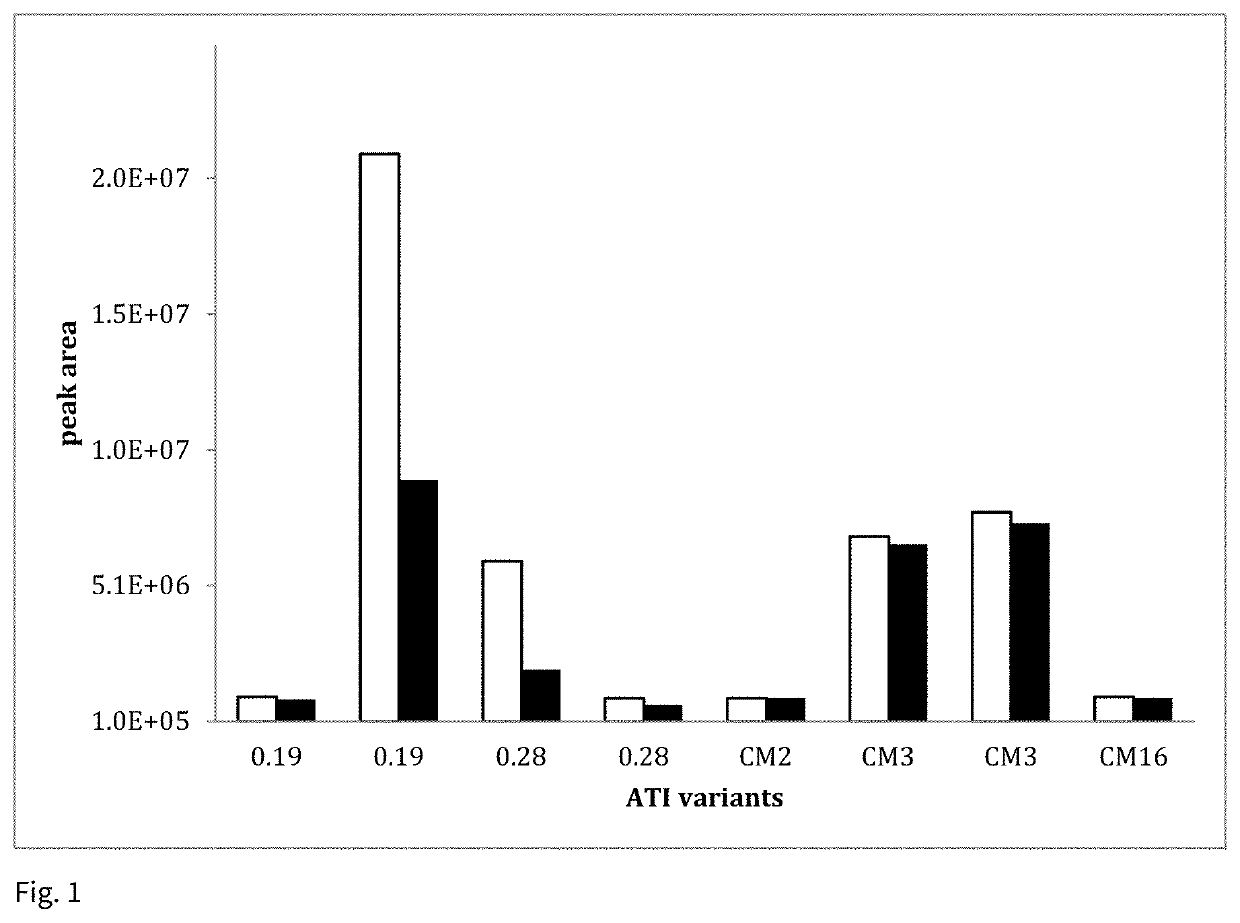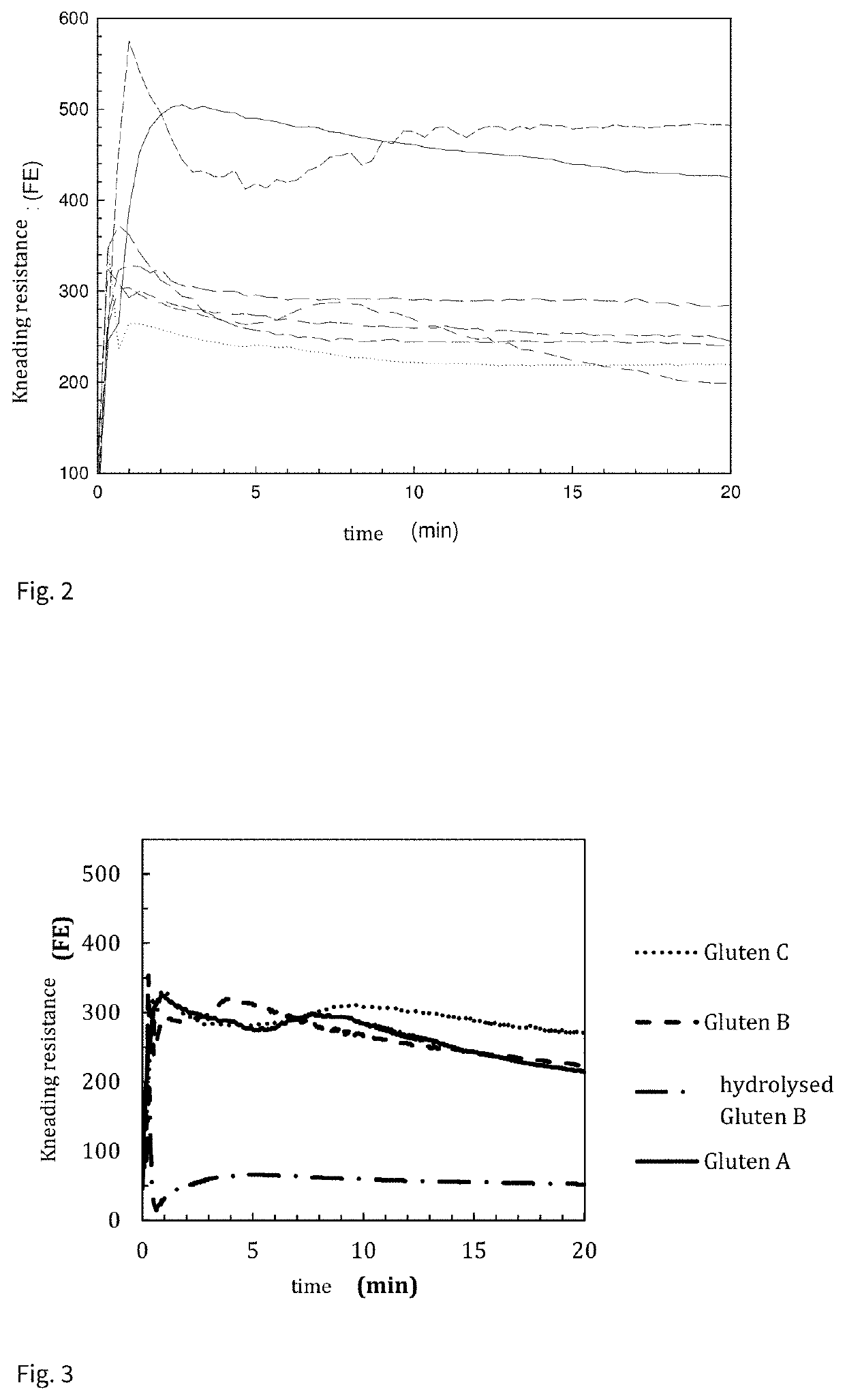Well-tolerated flour composition
a technology of flour composition and well-tolerated flour, which is applied in the field of food production, can solve the problems of life-threatening resorption disorder, limited patients, and no longer being able to eat the most common foods made from flour, and achieve the effect of better toleran
- Summary
- Abstract
- Description
- Claims
- Application Information
AI Technical Summary
Benefits of technology
Problems solved by technology
Method used
Image
Examples
example 1
of Different Compositions on the Dough Properties
[0099]Various mixing ratios of ATI-reduced wheat starch and ATI-reduced isolated wheat gluten were compiled and tested. The test doughs were kneaded in the farinograph until the maximum viscosity was reached. The doughs were round knitted with the roll press. The dough was then left to rest for 15 minutes. The doughs were then gently kneaded for a long time and formed into small strips of dough using the press. After a further rest period of 35 minutes, the measurement was carried out.
TABLE 1Test formulations and production overviewFormulationIngredients (g)#1#2#3#4#5#6#7Wheat flour (type 550)300000000(100%)Wheat starch0294252249254267245 (96%)(85%) (83%) (85%) (89%) (82%)Wheat gluten A0039.639.139.920.338.5(13%) (13%) (13%)(6.8%) (13%)Psyllium08.908.92.49.52.3(2.9%)(2.9%)(0.8%)(3.2%)(0.8%)Rapeseed oil04.23.63.63.63.83.5(1.4%)(1.2%) (1.2%)(1.2%)(1.3%)(1.2%)Sourdough00000010.5(Böcker Germe)(3.5%)Water174225179197205225198Kneading time6...
example 2
of Different Wheat Gluten on the Kneading Behaviour
[0103]The influence of different adhesives and isolated adhesive proteins on the rheological properties of the dough was investigated.
[0104]The different adhesives were used in the following formulation (#8), the amounts were not varied.
TABLE 3Formulation #8Quantity (g)Wheat starch245Wheat gluten38.5Psyllium2.3Rapeseed oil3.5Germe10.5Water198
[0105]For this purpose, gluten, i.e. isolated wheat gluten, was tested by various manufacturers. The results of the kneading curves are shown in FIG. 3.
[0106]Of particular interest was the result on hydrolysed gluten, where the kneading resistance is significantly reduced, as can be seen from the kneading curve. The other glues show a comparable kneading resistance, but the “2nd” increase is at different times.
example 3
of Different Amounts of Wheat Gluten on Baking Behaviour
[0107]The influence of different doses of wheat gluten should be investigated to determine the tolerance ranges of wheat gluten quantities. The amount of wheat gluten used in the previous test series was approx. 13% and represents the standard. In comparison, mixtures with approx. 4% up to approx. 20% gluten (based on the total amount of ingredients without water) were tested.
TABLE 4Test formulationsRecipe: #9Formulation #10:Formulation #11:Raw materialwith approx.with approx.with approx.in (g)4% adhesive12% adhesive19% adhesiveWheat starch105010501050Wheat gluten50165280Psyllium101010Germe24.824.824.8Rapeseed oil121212Yeast404040Salt252525Sugar151515TOTAL (g)1226.81341.81456.8Water (22° C.)735810900Kneading time2 + 82 + 92 + 9Dough rest15minutes15minutes15minutesWeighing in (g)650650650Fermentation time40min40min40min
[0108]The doughs with an adhesive content of less than 5% had almost no elastic properties. The doughs with an ...
PUM
| Property | Measurement | Unit |
|---|---|---|
| grain size | aaaaa | aaaaa |
| particle size | aaaaa | aaaaa |
| particle size | aaaaa | aaaaa |
Abstract
Description
Claims
Application Information
 Login to View More
Login to View More - R&D
- Intellectual Property
- Life Sciences
- Materials
- Tech Scout
- Unparalleled Data Quality
- Higher Quality Content
- 60% Fewer Hallucinations
Browse by: Latest US Patents, China's latest patents, Technical Efficacy Thesaurus, Application Domain, Technology Topic, Popular Technical Reports.
© 2025 PatSnap. All rights reserved.Legal|Privacy policy|Modern Slavery Act Transparency Statement|Sitemap|About US| Contact US: help@patsnap.com



